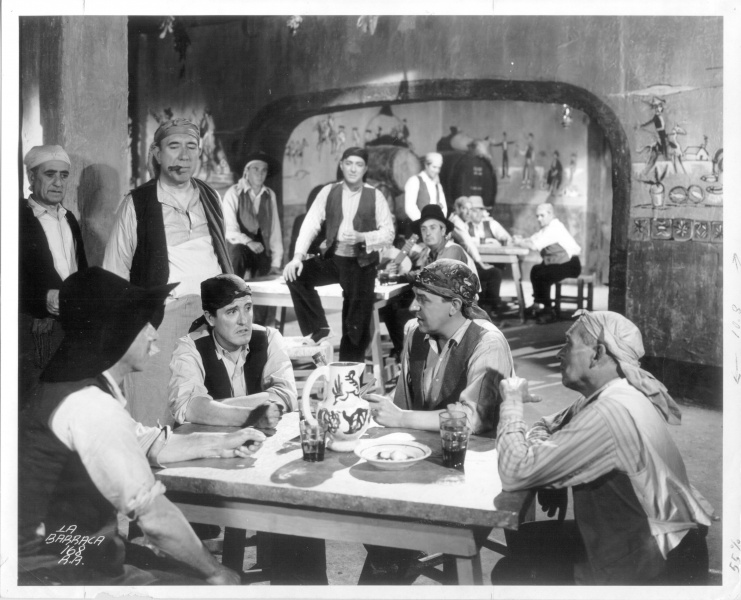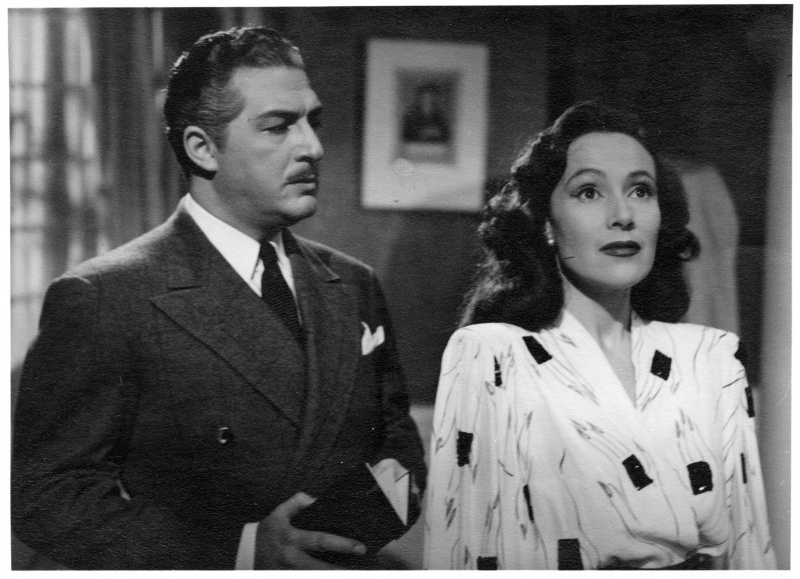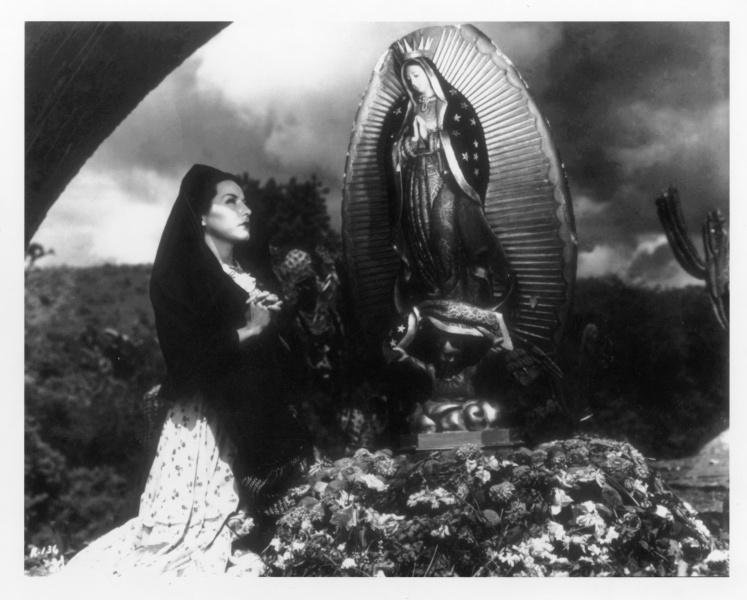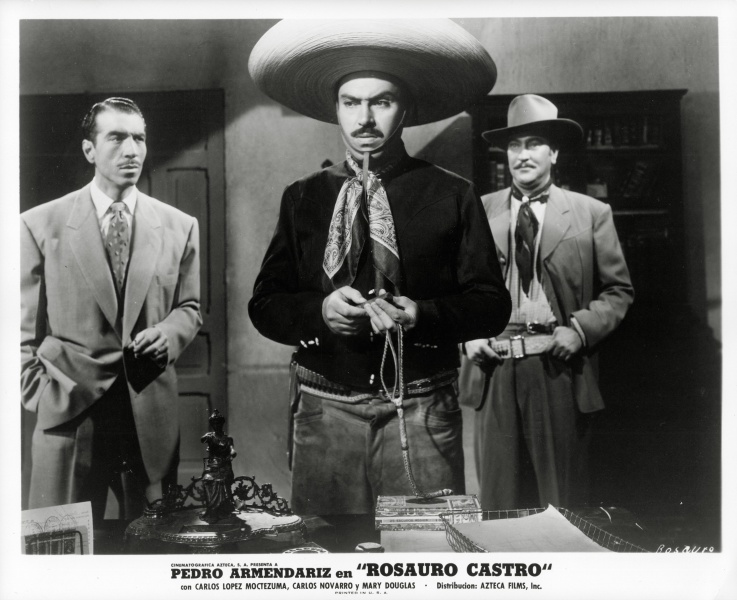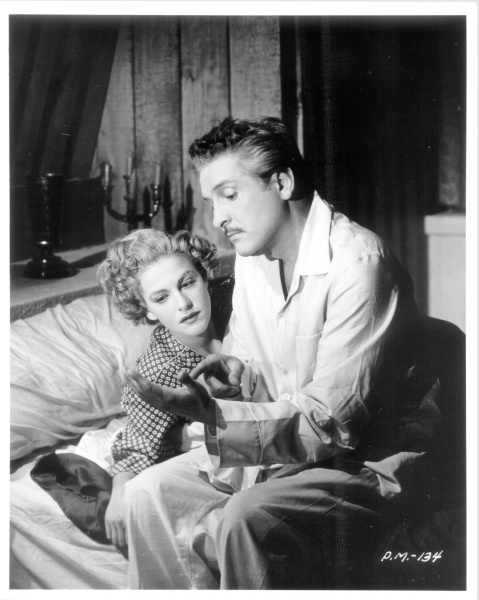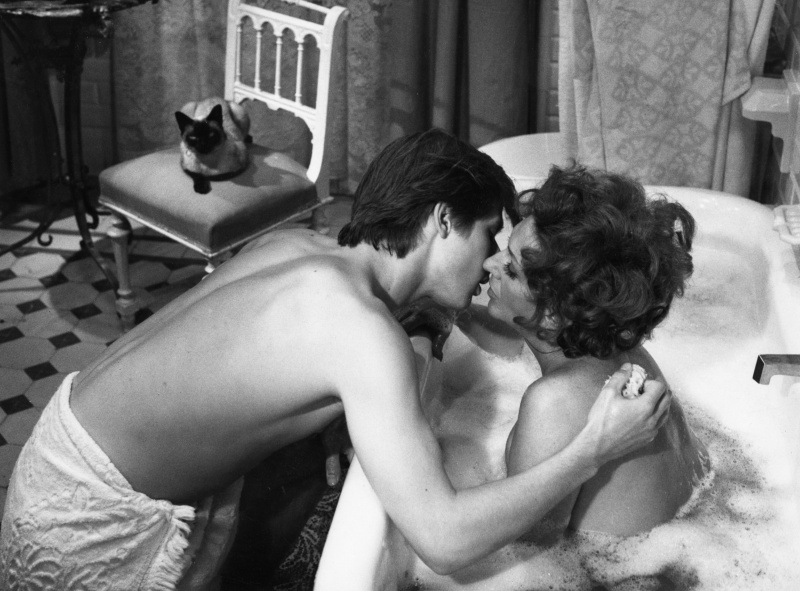The retrospective of the San Sebastian Festival’s 67th edition will see the screening of twenty feature films directed by the Mexican Roberto Gavaldón between 1945 and 1974. The cycle, organised with Filmoteca Española, will be accompanied by a monographic book dedicated to the filmmaker.
The publication will be coordinated by Quim Casas and Ana Cristina Iriarte and will include articles by Mirito Torreiro, Nuria Vidal, Dolores Tierney, Marina Díaz, Casas himself, and some of Mexico’s greatest experts on Gavaldón’s work: Rosario Vidal Bonifaz, Carlos Bonfil, Eduardo de la Vega, Fernando Mino, Viviana García Besné, Héctor Orozco, Rafael Aviña and Paula Astorga, former director of the Cineteca Nacional de México. Roberto Gavaldón Arbide, the filmmaker’s son, will participate in the presentation of the book.
The cycle has the collaboration of the Filmoteca Vasca and the San Telmo Museum and will, following its screening at the San Sebastian Festival, travel to Filmoteca Española in Madrid, where it can be seen in the months of October and November. Some of the titles programmed have been restored by the Cineteca Nacional de México and by the Filmoteca UNAM.

Roberto Gavaldón (1909-1986) is considered to have been one of Mexican cinema’s most important directors in the fifties and sixties. Born in Jiménez, in the Mexican state of Chihuahua, in 1909, he took his first steps in the medium working as an extra, actor, assistant director and scriptwriter. After a few jobs as co-director, he made his solo debut in 1945 with La barraca (The Plot of Land), adaptation of the novel by Vicente Blasco Ibáñez, with a production team including several Spanish technicians who had gone into exile in Mexico after the Civil War.
Already from that first feature film, Gavaldón made his mark with a highly sober, classic and realist style, benefitting from the collaboration with directors of photography such as Gabriel Figueroa, Alex Phillips and Jack Draper. He generally dealt with melodramatic topics. Both his style and the chosen storylines would later make him clash with the younger crop of critics and directors who questioned his predilection for national cinema.

Macario (1960), based on a story by Ben Traven – a writer who also gave John Huston his inspiration for The Treasure of the Sierra Madre, and whom Gavaldón would adapt once again in Rosa blanca (1961) and Días de otoño (Autumn Days,1963) – is one of his most important films: it participated in the Cannes Festival and was the first Mexican film to land an Academy Award nomination for best foreign language film. Its lead man, Ignacio López Tarso (one of the actors in Buñuel’s Nazarín), was one of the stars of Mexican cinema in those years. Gavaldón also worked with other big names of Mexican cinema, such as María Félix, Dolores del Río, Arturo de Córdova and Pedro Armendáriz, as well as with Argentina’s star of melodrama, Libertad Lamarque.
For years he was the leading representative of his country’s cinema at the big international festivals. He competed several times in Cannes, Venice and Berlin, presenting Acuérdate de vivir (Remember To Live) at the first edition of the San Sebastian Festival in 1953. He won eight Ariel awards, the accolades given from 1947 by the Mexican Academy of Film Arts and Sciences: the first Ariel Award for best film went to La barraca.

Although he mainly cultivated melodrama, he touched on numerous genres including crime, musical, fantasy and rural drama, also producing a western series with Antonio Aguilar. Outstanding among his films are titles such as Macario, La otra (The Other One, 1946) – a criminal drama about twin sisters embodied by Dolores del Río, reproduced in a Hollywood remake starring Bette Davis, Dead Ringer (1964) – La diosa arrodillada (The Kneeling Goddess,1947), En la palma de tu mano (In the Palm of Your Hand,1951), La noche avanza (Night Falls,1952) – starring an unscrupulous Basque pelota champion –, El rebozo de Soledad (Soledad’s Shawl, 1952), El niño y la niebla (The Boy and the Fog,1953), Camelia (1954), Sombra verde (Untouched, 1954), La escondida (The Hidden One,1956) and Miércoles de ceniza (Ash Wednesday,1958). In 1955 he was chosen by the Disney studios to direct one of its productions filmed in Mexico, The Littlest Outlaw.
In the early sixties he turned his attention to other topics, revealing an obvious preference for social and political issues. However, Rosa blanca, about the expropriation of petrol in Mexico, was forbidden and had its release delayed until 1972. In Días de otoño, starring the same couple as Macario, Ignacio López Tarso and the actress discovered by Gavaldón, Pina Pellicer, narrates the dark tale of a woman abandoned by her fiancé who tells everyone she has married the man and is pregnant with his child. Next he collaborated with Gabriel García Márquez and Carlos Fuentes on the screenplay of El gallo de oro (The Golden Cockerel, 1964), a parable about a fighting cock according to a story by Juan Rulfo.
In the first half of the seventies he produced three films in Spain: Don Quijote cabalga de nuevo (Don Quixote Rides Again,1973), with Fernando Fernán Gómez and Cantinflas in the parts of Don Quixote and Sancho Panza, and two dramas starring Amparo Rivelles, La madrastra (The Stepmother, 1974) and La playa vacía (1977). He continued to work until 1979, when he directed his last film, Cuando tejen las arañas, a drama about a young girl and her sexual repression. He died in Mexico City in 1986.
In rural Valencia, a new family arrives to work the land and live in the farmhouse of a family who has lost both to a moneylender. Despite having nothing to do with the situation, the neighbours are hostile to the idea of others working the land that was once their own.

María and Magdalena are twin sisters; one is a millionaire while the other is poor. María, the poor sister, kills her twin, recently widowed, in order to take her place. But the murderess will find herself with her back to the wall when she has to prove that she’s innocent of her husband’s murder, committed by her own victim.

Raised as brothers on a ranch, two men, Pedro and Carlos, vie for the love of the same woman, Lupe. Pedro and Lupe marry, but her fickle behaviour ends in tragedy.

Antonio Ituarte, a rich industrialist, gives his wife the statue of naked woman as a wedding anniversary gift. The model who posed for the statue is Raquel, Antonio’s mistress. Raquel demands that Antonio divorce his wife, who dies shortly afterwards in mysterious circumstances. Antonio believes that he has poisoned his wife when in fact he had intended to kill his mistress.


One of the candidates running for town mayor is murdered. The suspicions of the public prosecutor’s office fall on Rosauro Castro, the local despot. Rosauro’s young son is accidentally killed in a shoot-out. Rosauro wants revenge, but is intercepted by the mayor, his partner in crime.

Karin, an astrologer and occultist, is in fact a trickster who takes advantage of his clients’ gullibility, basing his information on the gossip he receives from his mistress Clara, a beauty salon assistant. Clara tells Karin that a millionaire, Vittorio Romano, has died on discovering that his wife Ada had betrayed him with his nephew, León. Pretending to have been a close friend of the dead man, Karin turns up at the funeral where he succeeds in making Ada confess that she and León poisoned Vittorio to get their hands on his fortune. Karin and Ada plot to kill León.


Doctor Alberto Robles considers himself to be a failure for not having fulfilled the dreams he had as a student of medicine and having had to go back to work in his little hometown. There he reunites with his two friends, Father Juan and Roque Suazo, opponents of the local despot like himself. One night, a woman called Soledad begs the doctor to come and see her brother, who is running a fever. He saves the boy’s life. The woman falls in love with the doctor and decides to show him her gratitude by going to help him every day. Meeting Roque Suazo upsets Soledad’s existence and brings tragedy into everybody’s life.

Marcos Arizmendi is an arrogant Basque pelota player accustomed to spreading his charm liberally among women. But a run-in with a bookie’s wiles puts his life in danger.

Yolanda, a piano teacher, moves to the capital when the man she loves marries her sister by mistake. There she teaches in a kindergarten and moves in with the family of one of her pupils. The mother is in a wheelchair and asks for her help to raise her children. But the man who had married Yolanda’s sister sows doubts in the eldest child as to whether there is something more to the relationship between Yolanda and Manuel, his father.


Rafael, a bullfighter by profession, dedicates a bull to the famous actress Camelia, but is later gored in the same bullfight. The relationship between the two deepens and they fall in love. She is ill with cancer. When, after clashing repeatedly, they go to his village to get married, Rafael’s brother Enrique recognizes Camelia as being his former lover, the woman he went to jail for. Convinced by his Enrique, Camelia leaves her husband, leaving a letter when she goes.

Federico works for a Mexican company and is sent into the jungle to find the area that produces the tree from which cortisone is obtained. Lost in the jungle, Federico finally arrives to an inhabited spot beside a waterfall. He is met with hostility by Santos, an embittered man who has turned his back on the world. Santos severs the footbridge and Federico plummets into the river. Yáscara, Santos’ daughter, saves Federico and falls in love with him, but he's a married man. A group of men rescue Federico and Yáscara is left alone. Her father tells her that if he loves her, he’ll come back.
Jesús Bernal has five sons. All are miners, but two of them go to school and have a teacher with liberal ideas. The Bernal family discovers a vein and registers it in their name, only to have it seized by a French company. When there is an explosion, the mine owners refuse to rescue the trapped workers, prompting the brothers to rebel against the company.


During the Cristero War in Mexico (in the 1920s), Victoria is raped by a Catholic priest, turning her against religion, and above all, the clergy. This, coupled with other tragic family experiences, makes her a very hard woman. In spite of coming from a good family, she becomes the madam of a brothel. But one day she falls in love with Doctor Federico Lamadrid, whose attitude makes her question her former beliefs and prejudices, especially when she discovers that he too is a priest.

Jim, an American sailor, returns to Topolobampo to find his old friend Pepe and propose a scheme to fish deep-water shrimps. Years earlier, while Pepe was serving a short jail sentence for having beaten up a man, Jim had had an adventure with Magdalena, Pepe’s wife. The child Pepe believes to be his own is really Jim’s. A chance remark by another fisherman consumes Pepe with suspicion and jealousy, which has repercussions on the boy and on his family life. Meanwhile, Magdalena resumes her relationship with Jim.

Macario, a poor peasant and woodcutter, longs to be able to eat a whole guajolote (turkey) all by himself, but his family’s situation is dire. One day, his wife steals a bird and cooks it only for him. He goes into the forest to eat it and has three apparitions: the Devil, God and Death. Each asks him to share his turkey with them, but he only accepts to do it with Death. In return, Death gives him a bottle of a liquid that cures all ills. His sudden wealth draws the attention of the Inquisition and Death ends up coming back to claim him.


Luisa is a small-town girl who arrives in Mexico City to work in a cake shop run by Don Albino, a widower with two small children who soon realises the girl’s great talent for decorating cakes. Although Luisa is fond of Don Albino’s children, she rejects his advances because she is about to be married. But on the wedding day the groom doesn’t appear. Devastated, Luisa returns to the cake shop, where she pretends to be married and pregnant.


When poor town crier Dionisio Pinzón is given a dying golden cockerel, he nurses it back to health and christens it his ‘golden cockerel’. After defeating one of the cocks owned by the famous cockfighter Lorenzo Benavides, the latter insists on buying the golden cockerel and making Pinzón his associate. With the help of ‘La Caponera’, Benavides and Pinzón become partners. But the deal won’t last long, and they end up on opposite sides for one last cockfight.


In 1937, the Rosa Blanca ranch owner refuses to sell his property to an American oil company. To convince him, they invite him to the United States, where they make him disappear. A little later, using a false document, the company takes possession of the property, destroying it to create an oilfield and proceeding to exploit the ranch workers. At the end of the film, mention is made of the oil industry nationalisation declared by President Lázaro Cárdenas in 1938.


Don Quixote is obsessed with chivalry and its codes of honour. Accompanied by his peculiar squire Sancho Panza, he embarks on a series of adventures in which he is mocked and tricked by some while others try to help him recover his sanity. But neither Don Quixote nor Sancho give up trying to protect humanity.
An important businessman marries Mercedes, a middle-aged prostitute, but dies shortly afterwards from severe consumption. Attracted to two men, her young stepson and his painting teacher, Mercedes sets about trying to seduce them, only to discover that the two having an affair.
COMPLETE YOUR LIBRARY
We remind you that you can purchase books of the previous years retrospectives on the Festival's Publications store


